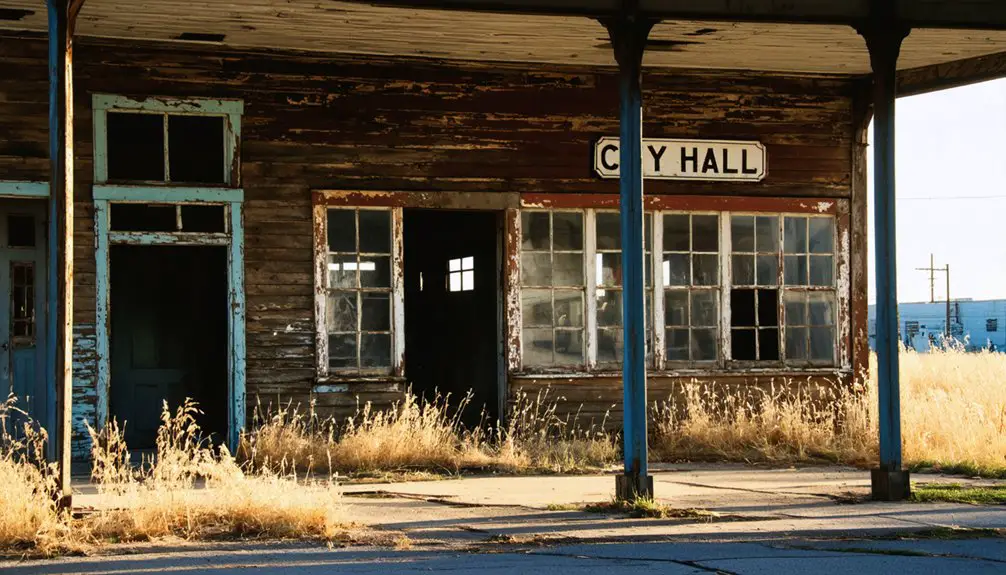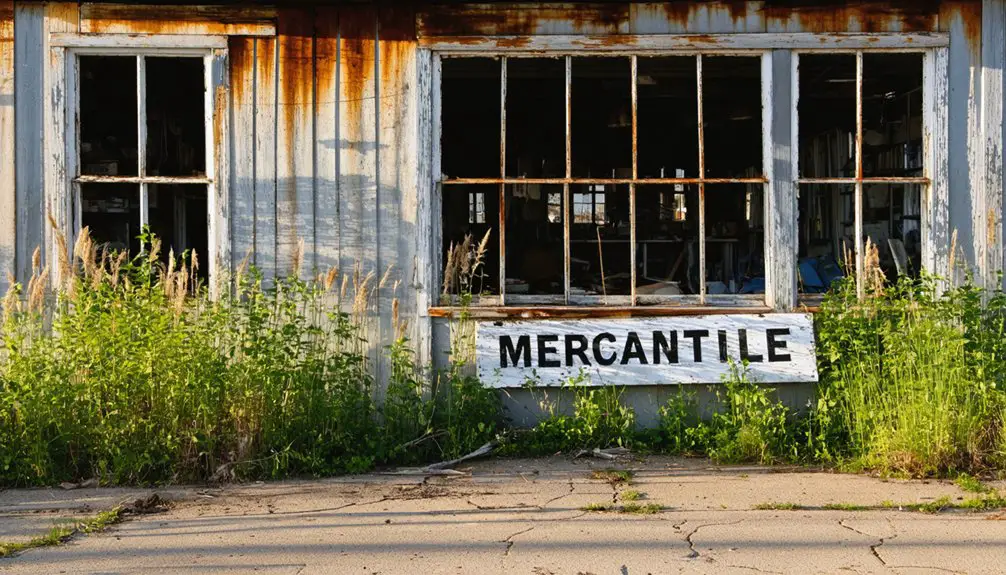You’ll find Meridian’s ghost town ruins along Rock Creek, where it flourished briefly after the Atchison, Topeka and Santa Fe Railroad arrived in 1872. Originally Kanza and Osage territory, the settlement grew around Albert Owens’ land with W.F. Cunningham’s first buildings and M.A. Gardner’s general store. Transportation changes and economic challenges gradually emptied the town, with its school’s 1970 closure marking a final blow. The site’s crumbling remains hold deeper stories of Kansas’s pioneer settlement era.
Key Takeaways
- Meridian was established in 1872 following the completion of the Atchison, Topeka and Santa Fe Railroad line.
- The town experienced early growth with W.F. Cunningham’s buildings and M.A. Gardner’s general store supporting initial development.
- Economic decline followed unsustainable resource industries and competition from larger towns with retail chains.
- Railroad route changes and transportation shifts led to Meridian’s isolation from major economic centers.
- The closure of local schools in 1970 accelerated population decline, leading to the town’s eventual abandonment.
The Birth of a Pioneer Settlement (1872)
Three pioneering events in 1872 marked Meriden’s birth as a Kansas settlement: the completion of the Atchison, Topeka and Santa Fe Railroad line in April, the establishment of a post office in May, and the construction of the first buildings by W.F. Cunningham.
You’ll find that the settlement dynamics centered around Albert Owens’ land, where early pioneers relocated structures from nearby Mount Florence, including a crucial blacksmith shop. The town flourished quickly with a local general store opened by M.A. Gardner. The original site was purchased by Albert Owen in 1869 before the town’s development began.
The pioneer challenges were met head-on as the community took shape. Dr. A. Dawson built the first permanent dwelling in November, while Cunningham’s railroad section foreman’s house served as an anchor point for the growing settlement.
Early settlers forged ahead, with Dr. Dawson and Cunningham’s houses becoming vital cornerstones of the burgeoning frontier community.
The town’s name came from a settler’s New Hampshire hometown, establishing Meriden’s identity as a frontier railway stop.
Native Roots and Early Land Disputes
Before Meridian’s pioneer settlement in 1872, you’d have found this land within the broader territory of Kansas’s native peoples, particularly the Kanza and Osage tribes who’d been granted reservations in the region through 1820s treaties.
You’ll recognize that prior to white settlement, multiple Native American tribes maintained overlapping territorial claims in the area, with villages traditionally positioned near crucial water sources. The Indian Removal Act dramatically accelerated the displacement of native tribes from their ancestral lands in the 1830s.
The eventual establishment of Meridian occurred during a complex period of native displacement and land disputes, as government policies increasingly pushed tribes onto smaller reservations while opening territory for white settlement. The Kanza people were forced into relocation in 1873, moving from their Kansas homeland to Indian Territory.
Native Territory Boundaries
While multiple Native American tribes called Kansas their ancestral home, the territory surrounding Meridian underwent dramatic changes during the 19th century as tribal lands were systematically reduced through treaties and government actions.
You’ll find that the Kansa, Osage, and Pawnee tribes originally held vast territories here before being forced to cede their lands. Natural features like rivers and ridges marked these intertribal boundaries, but they weren’t permanent.
Through a series of coerced treaties, especially in the 1850s and 1860s, native land cessions dramatically shrank tribal holdings. The General Allotment Act of 1887 established the federal policy of dividing tribal lands into individual parcels. The U.S. government’s policies transformed communal tribal lands into individual parcels, while establishing Indian Territory primarily in present-day Oklahoma.
These shifting boundaries reflected the growing pressures from settlers and changing federal policies toward Native lands.
Pre-Settlement Land Claims
Multiple native tribes maintained extensive territorial claims across Kansas before formal U.S. settlement, with the Kanza, Osage, Pawnee, and Comanche holding ancestral rights to vast regions.
You’ll find that their land tenure systems were based on communal stewardship rather than individual ownership, a practice that would soon face devastating disruption.
As U.S. expansion pushed westward, indigenous displacement accelerated through a series of treaties and congressional actions. The Doctrine of Discovery became the legal foundation for U.S. efforts to acquire native lands.
The Treaty of 1859 stripped the Kanza of their traditional lands, leaving families with mere 40-acre allotments – far too small to maintain their way of life.
Despite strong tribal opposition, the government’s push for individual land ownership, driven by railroad interests and settler demands, systematically dismantled native territories.
This set the stage for white settlement in areas like Meriden, where pre-1857 squatters established early claims.
The Indian Removal Act of 1830 had already set a devastating precedent by forcibly relocating over 46,000 Native Americans west of the Mississippi River.
Squatter Rights Conflicts
The unresolved tensions from tribal displacement soon erupted into new conflicts as squatters began staking unofficial claims in the Meriden area before 1857.
You’ll find that these early settlers fought bitterly over squatter ownership and land legitimacy, often resorting to violence when boundary disputes arose. Their conflicts weren’t limited to fights among themselves – they also challenged the government’s authority to sell the land, particularly in nearby Osawkee. Like the Osage tribes’ land cession in 1870, these territorial disputes shaped the region’s development.
The absence of clear legal frameworks made resolving these disputes nearly impossible.
While Native Americans had ancestral rights to these territories, their claims were largely ignored as settlers continued encroaching.
It wasn’t until the government’s 1857 land sales that a path toward legitimate ownership emerged, though many squatters resisted this shift to formal property rights.
Life Along Rock Creek’s Strategic Location
Due to its strategic position along Doniphan’s Expedition trail from Missouri to California, Rock Creek emerged as an essential frontier settlement in 1854 when William Wade first established roots there. Much like the town of Meriden, Connecticut, the location proved crucial for early development.
You’d find gold seekers camping along its banks, making use of the important water source that would later support thriving agricultural operations and livestock stations.
Community interactions centered around focal points like the Demeree/Dellinger farm‘s well and mixed-use establishments that served as both grocery stores and post offices. Similar to the later established Rock Creek Gardens neighborhood in Washington D.C., the area developed a strong sense of community identity.
The transportation evolution dramatically shaped life here – from the arrival of the Atchison, Topeka and Santa Fe Railway in the 1870s to the construction of K-4 highway in 1927.
The railway station brought telegraph communications, increased trade, and transformed Rock Creek into a bustling rural hub until the line’s closure in 1996.
Town Leadership and Civic Development

While Meridian’s establishment in January 1871 coincided with Sumner County’s organization, historical records reveal minimal civic development compared to neighboring settlements.
You’ll find that leadership challenges plagued the town from its inception, as nearby communities like Napawalla and Oxford overshadowed Meridian’s growth and competed for the county seat position.
Unlike its neighbors, Meridian’s civic initiatives remained significantly absent from historical documentation.
You won’t find records of schools, hospitals, or other public services that typically marked successful frontier towns.
The town’s governance structure and citizen-led projects are conspicuously missing from available sources, suggesting limited community organization.
While other settlements in Sumner County thrived with new physicians, ferries, and organized town companies, Meridian’s development stalled, leaving little trace of structured civic progress.
Economic Forces That Shaped Meridian
As frontier Kansas towns rose and fell with shifting transportation networks, Meridian’s economic trajectory followed patterns similar to other ghost towns like Sheridan and Honeywell.
Local commerce faced the relentless economic fluctuations common to railroad-dependent communities, where business survival hinged on transportation access and market reach.
- Rail construction created temporary booms as freight transfer points emerged, but rerouting could quickly drain a town’s significance.
- Resource-based industries like buffalo hunting and wool trading provided initial wealth but proved unsustainable.
- Competition from larger towns with retail chains drew customers away from small local businesses.
- Agricultural market shifts and centralization of commerce in regional hubs left towns like Meridian economically hollow, unable to maintain their commercial base without diversified industry.
The Path to Abandonment

You’ll find Meridian’s decline began with shifts in railroad traffic patterns, as the once-vital ATSF line diminished in importance during the late 1800s.
The town’s agricultural economy suffered from soil depletion and mechanization, while nearby grasshopper plagues reminded settlers of farming’s precarious nature.
These challenges triggered a steady exodus of residents, particularly younger citizens seeking opportunities in larger communities, which left Meridian increasingly hollow as essential services disappeared.
Early Transportation Changes
When transportation infrastructure shifted dramatically in Kansas during the late 1800s, Meridian’s fate became increasingly uncertain.
You’ll find that the transportation evolution across the region brought sweeping changes, as railroad expansion transformed the economic landscape. The traditional wagon roads and stagecoach stations that once sustained communities like Meridian quickly became obsolete.
- The Kansas Pacific Railway’s westward push created new economic centers while abandoning others.
- Established trade routes, including the crucial Smoky Hill Trail, lost significance as rail transport dominated.
- Stagecoach stations and outfitting businesses that served wagon travelers couldn’t compete with rail efficiency.
- Wells, Fargo & Co. and other stage operations ceased their services, reflecting the unstoppable shift toward railroad supremacy.
These changes fundamentally altered how goods and people moved through Kansas, leaving towns like Meridian vulnerable to decline.
Agricultural Economy Decline
The mechanization of agriculture in the late 19th and early 20th centuries dealt another devastating blow to Meridian’s survival. Agricultural innovation brought hybrid seeds, improved machinery, and large irrigation systems that increased productivity but reduced the need for farmworkers.
You’d have seen larger farms developing while smaller operations couldn’t compete with the mechanization impact.
As farming families left, Meridian’s economic foundation crumbled. Local businesses – from grocery stores to hardware shops – closed their doors when they couldn’t sustain themselves with the shrinking population.
The town’s younger generation sought opportunities in urban centers, leaving elderly residents behind. Without a stable tax base, municipal services declined, and infrastructure deteriorated.
The cycle of decline accelerated as abandoned buildings multiplied, making Meridian less attractive to potential new residents.
Population Migration Patterns
Although Meridian’s population decline began gradually in the early 1900s, several interconnected factors accelerated the town’s abandonment by mid-century.
You’ll find the rural exodus particularly intensified after the loss of essential community institutions, leading to irreversible migration trends that transformed this once-thriving railroad town into a ghost town.
- Young adults and families led the exodus, seeking better educational and employment opportunities in larger urban centers.
- The closure of local schools in 1970 prompted an immediate wave of family departures.
- Loss of rail service and business closures eliminated key employment opportunities, forcing working-age residents to relocate.
- The diminishing tax base created a downward spiral, as reduced services and infrastructure maintenance made the town less attractive to potential new residents.
Historical Significance in Kansas Settlement Era

Located strategically along Doniphan’s military trail, Meriden emerged as an important settlement during Kansas’s territorial expansion in the 1870s.
You’ll find its roots deeply connected to pioneer trails and settlement strategies that shaped the region’s development. The town’s establishment on Albert Owen’s farm in 1872 coincided with the railroad’s arrival, transforming it into a significant hub for settlers moving westward.
You can trace Meriden’s significance through its early infrastructure – from C.B. Shields’ post office to the hotel serving relief teams for horses and mules.
The town’s role extended beyond mere shelter, as it provided essential postal and trade services. While many similar settlements became ghost towns, Meriden’s position along transportation routes and its municipal framework helped establish its place in Kansas’s settlement history.
Frequently Asked Questions
Are There Any Remaining Structures or Ruins Visible in Meridian Today?
While you’d expect grand ruins from its railroad past, you won’t find many remaining buildings in today’s landscape – just scattered traces of streets and historical artifacts beneath overgrown fields.
What Happened to the Residents When Meridian Became Abandoned?
You’ll find the residents’ fate involved gradual community dispersal, with families relocating to nearby towns like Coyle for schools, jobs, and services after railroads closed and businesses shuttered.
Was Meridian Ever Connected to Any Significant Historical Criminal Activities?
Like a blank canvas, you won’t find any dark brushstrokes in Meriden’s crime history. Local legends and historical records don’t indicate any significant criminal activities in this Kansas town.
Did Any Famous Pioneers or Historical Figures Visit Meridian?
You won’t find records of famous visitors to Meriden except Col. Doniphan’s expedition passing through. The town’s historical significance stems from being on pioneer trails rather than hosting notable figures.
Were There Any Notable Natural Disasters That Affected Meridian’s Development?
Mighty Meridian’s most momentous disaster was the devastating 1908 fire that destroyed downtown. You won’t find records of significant tornado impact or flood damage affecting the town’s development path.
References
- https://www.jchsks.com/communities-meriden
- https://www.youtube.com/watch?v=alC1wDdSVvg
- https://meridenks.com/index.php/about-us/history
- https://www.youtube.com/watch?v=OyBXD18P_j4
- https://en.wikipedia.org/wiki/List_of_ghost_towns_in_Kansas
- https://swissmennonite.org/wp-content/uploads/2018/11/Pioneer-Life-and-Lore-of-McPherson-County-Kansas-Wayne-digitized-072617.pdf
- https://en.wikipedia.org/wiki/Meriden
- https://www.kancoll.org/books/cutler/ellsworth/ellsworth-co-p7.html
- https://legendsofkansas.com/native-american-history-kansas/
- https://en.wikipedia.org/wiki/History_of_Kansas



